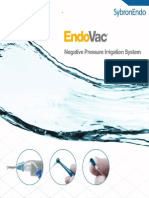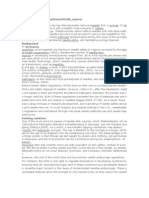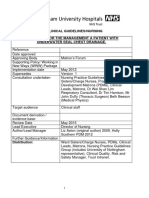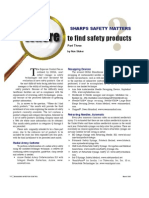Needless Connector
Needless Connector
Uploaded by
psp710Copyright:
Available Formats
Needless Connector
Needless Connector
Uploaded by
psp710Copyright
Available Formats
Share this document
Did you find this document useful?
Is this content inappropriate?
Copyright:
Available Formats
Needless Connector
Needless Connector
Uploaded by
psp710Copyright:
Available Formats
Sharps Safety
Advances in
Needleless Connectors
Technologies assist in prevention of bloodstream infections by Ron Stoker
D
ecember 1991, OSHA published the Bloodborne Many changes have occurred since I started my career
Pathogens Standard to protect workers from the in the medical device industry almost 29 years ago. One of
risk of bloodborne pathogen exposure. The standard the major changes has been in the products used to accom-
became effective in March 1992. The Bloodborne Pathogen plish intravascular infusion. Let's look at how IV infusion
Standard applied to all employers that had employees with systems have changed over time.
reasonably anticipated occupational exposure to blood or other
potentially infectious materials or OPIM. The Bloodborne Needle Access Injection Port
Pathogen Standard was applied to healthcare workers and some Almost every catheter that was used 29 years ago had
general industries as well, e.g., first aiders. In September, 1998 an injection port placed on the proximal end. The injection
California passed the first needlestick safety law requiring the use port consisted of a small piece of plastic covered with latex
of safety products. A number of other states have passed similar rubber that was constricted with a small band around it.
legislation mandating the use of safety products. (See Figure 1.) Injections were made by inserting a sharp
In September 1998, following the adoption of the California conventional needle into the latex dam and injecting
law, Federal OSHA issued a Request for Information (RFI) on medication. The purpose of the injection cap was to provide
available safety products. The information that was gathered from an avenue into the patient's venous system without having
the RFI indicated the feasibility and availability of a number of to stick another needle into the patient. The needle access
safer medical devices. It also showed the importance of work practice injection port was easy to disinfect. The commission would
controls and training when new safety products were introduced. simply wipe the top of the latex dam with an appropriate
In May of 1999, the Stark-Boxer Healthcare Worker Needlestick alcohol pad. Since only a small needle was being withdrawn
Prevention Act was introduced to Congress. A modified Needlestick from the injection port there was a minimal negative
Safety and Prevention Act was introduced by Congressman Cass displacement of blood in the catheter. Needles were often
Ballenger of North Carolina. The Act was passed unanimously in “secured” with tape. Unfortunately, as we all know, tape did
the House and Senate. President Bill Clinton signed the Act into not provide very good securement and disconnection often
law in November 6, 2000.
The Act required OSHA to revise the Bloodborne Pathogen Figure 1.
Standard to mandate the use of safer products and to reduce the
exposure of clinicians to bloodborne pathogens. A new definition of
a needleless system was provided in this revised standard.
A needleless system was defined as a medical device that does
not use a needle for the collection of bodily fluids, administration
of medications, administration of fluids, and any other procedure
with potential percutaneous exposures to a contaminated sharp.
By using a needleless system fewer needles would be used and
needlestick injuries could be avoided.
A needleless connector is still one of the best ways to prevent
needlestick injuries—by eliminating as many needles as possible.
By eliminating the needles and replacing them with a non-needled
device means that you can't be stuck by needle that is not there.
No needle—no risk!
16 MANAGING INFECTION CONTROL May 2009
Sharps Safety
Needleless systems used on IV tubing have made one of
the greatest impacts in reducing needlestick injuries.
occurred. In addition, many healthcare workers receive Medications would be administered inserting the blunt
needlestick injuries using this type of product. Many needles cannula into the pre-pierced septum. This type of system
were also recapped following injection and additional needle- eliminates the use of a sharp needle but it also has some draw-
stick injuries occurred. As we are all aware, there were no backs. Right beneath the split septum is located an area that
governmental or regulatory requirements to use any type of accommodates the introduction of the cannula. If the clinician
safety device at this time period. fails to properly use a positive-pressure flush technique or
Although needleless IV systems were available at a clamp on the system connection, blood can flow back up into
the time, only about 50 percent of hospitals were using the patient's infusion catheter. This can create a risk of clotting
needleless IV systems by 1995. Many healthcare organiza- of the catheter and can elevate the risk of infection. Another
tions were slow to adopt or did not adopt needleless drawback of this type of system is that conventional hypodermic
systems. One of the excuses used for this was the increased needles can mistakenly be used with this system, circumventing
cost of the devices even though the benefits were proven to the advantage of the blunt cannula. The split-septum products
save lives. did not address the problem of catheter occlusion. Split-septum
However, following the 2001 revised Bloodborne connectors created negative pressure when the blunt cannula was
Pathogen Standard; healthcare facilities began to adopt withdrawn. Any negative pressure at the time of disconnection
needleless connectors in much greater numbers. Needleless can jeopardize device patency by allowing retrograde flow into
systems used on IV tubing have made one of the greatest the lumen of the catheter.
impacts in reducing needlestick injuries. The needles that
were used on injection ports in IV tubing accounted for the Luer-Activated Ports—Negative Displacement
highest rate of sharps injuries. Following the adoption of the Needlestick Safety and
Prevention Act, Luer-activated mechanical valves began to be
Pre-pierced Septum and Blunt Cannula used on a more frequent basis. When the male luer is inserted into
Injection caps began to be replaced with pre-pierced the connector a valve opens and fluid can be infused or aspirated.
septum and blunt cannula. These consisted of a re-sealable Once the luer is removed the valve closes automatically. This
port that attached to the hub of the patient's access device. provides intermittent access to the vasculature and removes the
A blunt needle or cannula could be used to repeatedly need for either a conventional sharp needle or a blunt needle.
penetrate the septum. This blunt needle eliminated the need These were both positive steps in patient and healthcare worker
for a sharp needle and would provide intermittent access to safety. Needlestick injuries were reduced because the needle had
the vascular system. (See Figure 2.) been removed from the system. (See Figure 3.)
Figure 2. Figure 3.
18 MANAGING INFECTION CONTROL May 2009
Sharps Safety
Figure 4.
A needleless connector is
still one of the best ways to
prevent needlestick injuries—
by eliminating as many needles
as possible.
However the luer- activated design posed some other
risks. One of the problems created by the luer-activated
design is the inadvertent negative fluid displacement that
occurrs when the male luer is removed from the connector.
This negative fluid displacement pulls blood into the An additional connector has been designed with a positive
catheter lumen and intraluminal thrombotic catheter block- push feature that gives an overall negative fluid displacement and
ages can occur. Not only does this create occlusions but therefore no retrograde blood movement into the catheter lumen.
increases the potential for growth of microorganisms which
could flow into the patient's bloodstream. When a catheter Latest Advances
occlusion occurs, clinicians administer anti-thrombolytic Luer-Activated Ports—
agents to de-clot the line. This increase in manipulation of Clear with Anti-Microbial Technology
the line costs the hospital time and money. It also increases In the latest advance in luer-activated ports, Maximus
the patient's risk of infection due to contamination. The Medical, a division of Medegen, has recently introduced the
catheters often have to be replaced because the blood clot MaxGuard™ Advanced Luer Activated Device featuring Agion®
could not be removed. This is both difficult for the patient antimicrobial technology. (See Figure 5.)
and expensive. It became very important for clinicians to
maintain the patency of the catheters.
Figure 5.
Many clinicians started to note an increase in blood-
stream infections with the use of these products. It has been
theorized that this is due to the inability of disinfecting the
surface of the device. The theory is that the lack of a flat,
smooth surface where the male luer connector would be
inserted could be a problem. The newer products had
crevices and recesses that were supposedly difficult to
disinfect on the top of the valve. Some luer-activated
connectors were found to cause an increase in bloodstream
infections in several studies.
Luer-activated Ports—Positive Displacement
A number of companies started to design luer-activated
valves that displace fluids as the male luer was removed.
The concept is that after the syringe is removed from the Many hospitalized patients receive medications and nutritional
connector, the needleless connector pushes a small support intravenously. During the process of administering
amount of solution out of the connector distally. This intravenous medication, environmental contaminants can be
would then push fluid out of the distal end of the catheter introduced into the bloodstream. This is of particular concern if
and would totally fill the catheter with solution thus mini- proper infection prevention techniques are not followed. MaxGuard
mizing occlusion. This positive pulse of fluid clears the with antimicrobial technology helps prevent contamination and
catheter tip from blood, thus making occlusions less likely growth of microorganisms at the point of entry into the catheter, and
to form because blood is not sitting in a catheter for an subsequently in the bloodstream. MaxGuard is new technology
extended period of time. (See Figure 4.) introduced to assist hospitals in reducing catheter-related
20 MANAGING INFECTION CONTROL May 2009
Sharps Safety
bloodstream infections. This latest advance in luer-activated for healthcare-associated infections (HAIs), healthcare
needleless connectors helps clinicians prevent bloodstream professionals are seeking techniques and technologies to
infections. This will help to provide clients with a product that assist in their bloodstream infection prevention efforts. ✛
significantly improves their efforts to enhance patient care and
positive outcomes.
The MaxGuard positive displacement connector not only
contains antimicrobial technology but it is clear which provides Ron Stoker is the founder and executive director of
a visualization of the fluid path. It features a positive displace- the International Sharps Injury Prevention Society (ISIPS)
ment technology that provides a bolus of fluid to clear the and is a frequent contributor to Managing Infection Control
catheter tip upon disconnection from the device. It also features magazine. He speaks frequently at national and international
Medegen’s patented Tru-Swab® top which acts as a double seal meetings on sharps safety, hand hygiene and infection
barrier to contamination and allows for true disinfection during control issues. He is co-author of the “Compendium of
pre-access swabbing. The translucent housing provides for Infection Control Technologies.” For more information on
visualization of the fluid path allowing for complete flushing the Compendium, go to http://kunaki.com/Sales.asp?PID=
of the device. PX00OLESG1. Mr. Stoker is providing a number of webinars
The introduction of MaxGuard comes at a time when blood- focusing on a variety of sharps injury prevention safety
stream infection rates continue to be a major concern among products. For more information on the webinars, go to
hospitals. With the new federal policy restricting reimbursement www.isips.org/seminars.html.
Reader Service No. 63
May 2009 MANAGING INFECTION CONTROL 21
You might also like
- Epp Grade 6 2nd Periodical ExamDocument5 pagesEpp Grade 6 2nd Periodical ExamAlmarieSantiagoMallabo91% (34)
- Venous Access Devices - ManagementDocument276 pagesVenous Access Devices - ManagementCucuteanu Dan100% (1)
- Novel Technique For Management of Bartholin Gland CystsnDocument3 pagesNovel Technique For Management of Bartholin Gland CystsnelenNo ratings yet
- Tubing Misconnections Self Assessment For Healthcare FacilitiesDocument38 pagesTubing Misconnections Self Assessment For Healthcare FacilitiesAle Gastelum100% (1)
- China Regulatory Process and Approval TimelineDocument2 pagesChina Regulatory Process and Approval Timelinepsp710No ratings yet
- Thermoplastic Polyurethanes As Medical Grade Thermoplastic ElastomerDocument7 pagesThermoplastic Polyurethanes As Medical Grade Thermoplastic Elastomerpsp710No ratings yet
- Track WiseDocument12 pagesTrack Wisepsp710No ratings yet
- Battling Beetles Honors LabDocument6 pagesBattling Beetles Honors LabAakash Reddy0% (2)
- Chapter Two 2 Literature Review 2.1 The Pineapple PlantDocument25 pagesChapter Two 2 Literature Review 2.1 The Pineapple PlantRasheed67% (6)
- Vasofix SafetyDocument6 pagesVasofix Safetydex99No ratings yet
- Design and Manufacturing of Catheter Protector DeviceDocument6 pagesDesign and Manufacturing of Catheter Protector DeviceIJRASETPublicationsNo ratings yet
- f3 Proposal Ebp PortfolioDocument10 pagesf3 Proposal Ebp Portfolioapi-403426594No ratings yet
- TensesDocument16 pagesTensesPanthers leoNo ratings yet
- OJOLNS-10 - II - Invited Editorial PDFDocument5 pagesOJOLNS-10 - II - Invited Editorial PDFDR K C MALLIKNo ratings yet
- NCM 112 Lesson3Document6 pagesNCM 112 Lesson3Trisha LopezNo ratings yet
- Pmls 2-Chapter 5: By: Sherwin P. Gammad, RMT, LPT, MSPHCDocument141 pagesPmls 2-Chapter 5: By: Sherwin P. Gammad, RMT, LPT, MSPHCKhelly Joshua UyNo ratings yet
- Artikel Becton Dickinson - EngDocument7 pagesArtikel Becton Dickinson - EngSinggih NugrohoNo ratings yet
- Tape: A Dirty Business: by Steve Bierman, MDDocument11 pagesTape: A Dirty Business: by Steve Bierman, MDshinichi_kudoNo ratings yet
- Tugas EnglishDocument3 pagesTugas EnglishMaqfirotul RohmaNo ratings yet
- (Wildcat - Workers' Movements and Global Capitalism) Immanuel Ness - Southern Insurgency - The Coming of The Global Working Class-Pluto Press (2015)Document6 pages(Wildcat - Workers' Movements and Global Capitalism) Immanuel Ness - Southern Insurgency - The Coming of The Global Working Class-Pluto Press (2015)Spirit of 9/11No ratings yet
- JOURNAL Sharps Management and The Disposal of Clinical WasteDocument5 pagesJOURNAL Sharps Management and The Disposal of Clinical WasteVincent ReyesNo ratings yet
- Current Engineering and Clinical Aspects of Needle-Free Injectors - A ReviewDocument11 pagesCurrent Engineering and Clinical Aspects of Needle-Free Injectors - A ReviewAyushmanSrivastavaNo ratings yet
- Info Ventilator Low Cost - 3 - MIT - 11042020Document378 pagesInfo Ventilator Low Cost - 3 - MIT - 11042020anset1977No ratings yet
- An Analysis of Surgical Smoke Plume Components, Capture, and EvacuationDocument10 pagesAn Analysis of Surgical Smoke Plume Components, Capture, and EvacuationJORGE ANDRES SOTO FORERONo ratings yet
- RSOP Pneumatic TourniquetsDocument10 pagesRSOP Pneumatic Tourniquetsdr_hafizNo ratings yet
- Curso - Seguridad - Biológica - M3 - 21 - Safer Needle DevicesDocument6 pagesCurso - Seguridad - Biológica - M3 - 21 - Safer Needle DevicesMarcel PlaNo ratings yet
- Incidence of Microperforation For Surgical GlovesDocument7 pagesIncidence of Microperforation For Surgical GlovesLuciana MartinsNo ratings yet
- Endoscopic Clip ApplicationDocument5 pagesEndoscopic Clip ApplicationCastroNo ratings yet
- Venipuncture: From Wikipedia, The Free EncyclopediaDocument5 pagesVenipuncture: From Wikipedia, The Free Encyclopediaishinaki28No ratings yet
- Tourniquet Application During AnesthesiaDocument7 pagesTourniquet Application During AnesthesiaaksinuNo ratings yet
- Vessel Harvesting PDFDocument6 pagesVessel Harvesting PDFV RNo ratings yet
- 2019 - SAGE - MICS Aortic Valve Replacement With Sutureless Valves, International Prospective RegistryDocument11 pages2019 - SAGE - MICS Aortic Valve Replacement With Sutureless Valves, International Prospective RegistryOmán P. Jiménez A.No ratings yet
- Medical InstrumentationDocument125 pagesMedical InstrumentationRenu MegNo ratings yet
- A Study of Clinicians' Views On Medical Gloves and Their Effect On Manual PerformanceDocument7 pagesA Study of Clinicians' Views On Medical Gloves and Their Effect On Manual PerformanceAdel AdielaNo ratings yet
- Tourniquet Evaluation On Perfused CadaversDocument5 pagesTourniquet Evaluation On Perfused CadaversJean CotteNo ratings yet
- Oral Oncology: CORONA-steps For Tracheotomy in COVID-19 Patients: A Staff-Safe Method For Airway ManagementDocument3 pagesOral Oncology: CORONA-steps For Tracheotomy in COVID-19 Patients: A Staff-Safe Method For Airway ManagementCorin Boice TelloNo ratings yet
- Aesculap Ds Appendectomy ClipDocument12 pagesAesculap Ds Appendectomy ClipdoniNo ratings yet
- Torniquete 2Document7 pagesTorniquete 2thaisNo ratings yet
- Wound Drain FinalDocument16 pagesWound Drain Finaljosephnoon1100% (1)
- What Is A MicrodebriderDocument7 pagesWhat Is A MicrodebriderIqbalur100% (1)
- Insertion Mangement Peripheral IVCannulaDocument20 pagesInsertion Mangement Peripheral IVCannulaAadil AadilNo ratings yet
- Use of Scrubs and Related ApparelDocument4 pagesUse of Scrubs and Related ApparelReza KhajeNo ratings yet
- Endovac BrochureDocument8 pagesEndovac BrochureGeorge MK100% (1)
- Management of The Artificial AirwaDocument17 pagesManagement of The Artificial AirwaGuillermoAlphonsoVasquezGiglioNo ratings yet
- 1 s2.0 S2214541920300213 MainDocument4 pages1 s2.0 S2214541920300213 MainWinda KhosasiNo ratings yet
- 2714 - Peripheral Venous Catheter Care Policy For AdultsDocument10 pages2714 - Peripheral Venous Catheter Care Policy For AdultssofiinhaptNo ratings yet
- Neddlestick InjuriesDocument53 pagesNeddlestick InjuriesRobins Dhakal100% (1)
- Surgical Techniques in Cochlear ImplantDocument12 pagesSurgical Techniques in Cochlear Implantretribution499No ratings yet
- Needle CutterDocument6 pagesNeedle CutterPaul Anthony Centeno PimentelNo ratings yet
- Justification ThromboisiDocument2 pagesJustification ThromboisinishthaNo ratings yet
- Mder 8 381Document8 pagesMder 8 381muhammadaslamNo ratings yet
- Looking To File A Surgical Stapler Complications LawsuitDocument6 pagesLooking To File A Surgical Stapler Complications LawsuitSteven KingNo ratings yet
- SuturesDocument40 pagesSuturesMehboob AlamNo ratings yet
- 6.underwater Seal Chest DrainageDocument22 pages6.underwater Seal Chest DrainageEvieta CallysthaNo ratings yet
- Becton Dickinson and Needle SticksDocument5 pagesBecton Dickinson and Needle Stickssibajubiru100% (1)
- PRECAUTIONS FOR-WPS OfficeDocument5 pagesPRECAUTIONS FOR-WPS Officemkoboni23No ratings yet
- Jurnal Suction English PDFDocument4 pagesJurnal Suction English PDFJoko SuprionoNo ratings yet
- Maintenance of Gastrointestinal EndoscopesDocument8 pagesMaintenance of Gastrointestinal Endoscopesracrc3No ratings yet
- Hunter, KS - Characterization of Micro-Invasive Trabecular Bypass Stents by Ex Vivo Perfusion and Computational Flow ModelingDocument8 pagesHunter, KS - Characterization of Micro-Invasive Trabecular Bypass Stents by Ex Vivo Perfusion and Computational Flow ModelingtfjieldNo ratings yet
- Sensor To Detect Endothelialization On An Active Coronary StentDocument7 pagesSensor To Detect Endothelialization On An Active Coronary StentfahmiNo ratings yet
- 16 ISC Summary Safer Medical Device TermsDocument6 pages16 ISC Summary Safer Medical Device TermsMario GutiérrezNo ratings yet
- 30 Years - 30 Devices Mddi-3Document1 page30 Years - 30 Devices Mddi-3titov pensezNo ratings yet
- Olmstead Report AmcDocument4 pagesOlmstead Report AmcBethany100% (1)
- Safety in PipettingDocument3 pagesSafety in PipettingtwsnagelNo ratings yet
- Retrofit Measures For COVID-19: Smart Hospital ProjectDocument17 pagesRetrofit Measures For COVID-19: Smart Hospital ProjectcodefinderNo ratings yet
- Keys to Successful Orthotopic Bladder SubstitutionFrom EverandKeys to Successful Orthotopic Bladder SubstitutionUrs E. StuderNo ratings yet
- Europe IVD Regulatory ProcessDocument1 pageEurope IVD Regulatory Processpsp710No ratings yet
- Evaluating World Class Performance MeasurementDocument5 pagesEvaluating World Class Performance Measurementpsp710No ratings yet
- FG00084 V1 Risk ChecklistDocument5 pagesFG00084 V1 Risk Checklistpsp710No ratings yet
- P&G-Touching Lives Improving LifeDocument15 pagesP&G-Touching Lives Improving Lifepsp710No ratings yet
- Care & Cleaning - Stainless Steel PDFDocument7 pagesCare & Cleaning - Stainless Steel PDFpsp710No ratings yet
- ARBURG Customer Training GermanyDocument28 pagesARBURG Customer Training Germanypsp710No ratings yet
- IMM Online TRGDocument35 pagesIMM Online TRGpsp710No ratings yet
- Sharp Safety 3Document8 pagesSharp Safety 3psp710No ratings yet
- The Little Book of FlowDocument33 pagesThe Little Book of Flowpsp7100% (1)
- How To Draw - Drawing and Detailing With Solid WorksDocument52 pagesHow To Draw - Drawing and Detailing With Solid Workspsp71088% (8)
- The Dangers of Plastic BagsDocument36 pagesThe Dangers of Plastic Bagsbrandisessions100% (2)
- The Hawk and The HenDocument1 pageThe Hawk and The Henalmira villarealNo ratings yet
- 6th Semester Project PosterDocument1 page6th Semester Project PosterJoydeep NaskarNo ratings yet
- ED-Operator's Manual For GYROCOMPASSDocument190 pagesED-Operator's Manual For GYROCOMPASSsemjonovs.nikitaNo ratings yet
- Chapter 12chemical KineticsDocument5 pagesChapter 12chemical KineticsKevin HuangNo ratings yet
- Does The Dutch Court Case Against Shell Have Consequences For National Road Authorities - Transport & EnvironmentDocument3 pagesDoes The Dutch Court Case Against Shell Have Consequences For National Road Authorities - Transport & EnvironmentcaiqumeloNo ratings yet
- Fourier Transform and It's ApplicationsDocument24 pagesFourier Transform and It's ApplicationsImranNo ratings yet
- Lab - Report - 1Document7 pagesLab - Report - 1rafinsafayatNo ratings yet
- Ventilation of Health Care Facilities: ANSI/ASHRAE/ASHE Addendum M To ANSI/ASHRAE/ASHE Standard 170-2017Document9 pagesVentilation of Health Care Facilities: ANSI/ASHRAE/ASHE Addendum M To ANSI/ASHRAE/ASHE Standard 170-2017Hamad ElkasehNo ratings yet
- VTU Nanotechnology SyllabusDocument45 pagesVTU Nanotechnology SyllabusSantosh MysoreNo ratings yet
- Science&Esp7 WHLPDocument52 pagesScience&Esp7 WHLPCharmaine MillaminaNo ratings yet
- Soal Uas BHS Inggris KLS 3#Document7 pagesSoal Uas BHS Inggris KLS 3#agung bidiNo ratings yet
- Reading 1 Dreaming of AfricaDocument1 pageReading 1 Dreaming of AfricaMicaela Vilela100% (1)
- Mot Spur GearDocument8 pagesMot Spur GearRavi Mirza100% (1)
- (Underwater) Panty and Stocking With Garterbelt - 01-13 + OVA (BD 720p) (Dual Audio) (Batch) - TorrentDocument1 page(Underwater) Panty and Stocking With Garterbelt - 01-13 + OVA (BD 720p) (Dual Audio) (Batch) - TorrentzanetowerfinderNo ratings yet
- SAA3049Document17 pagesSAA3049dr_best_001No ratings yet
- The Ignatius Bible 2nd Edition - Ignatius PressDocument2,706 pagesThe Ignatius Bible 2nd Edition - Ignatius Presstherevenge030692No ratings yet
- Analysis of Surface Roughness On MachiningDocument4 pagesAnalysis of Surface Roughness On MachiningPermadi YusufNo ratings yet
- Ni 0215Document10 pagesNi 0215renatoredeNo ratings yet
- The Production of Pyruvate and Acetaldehyde During The Fermentation of Glucose by YeastDocument17 pagesThe Production of Pyruvate and Acetaldehyde During The Fermentation of Glucose by Yeastsizakele minenhleNo ratings yet
- 05 02 Direct Method of InterpolationDocument9 pages05 02 Direct Method of InterpolationJohn Bofarull Guix100% (1)
- EFFC & DFI - Tremie Concrete For Deep Foundations 2018Document83 pagesEFFC & DFI - Tremie Concrete For Deep Foundations 2018Nelson ChinNo ratings yet
- Rheumatic FeverDocument56 pagesRheumatic Feveralmawang100% (1)
- Miss Moppet's Mouse by Claire GarlandDocument10 pagesMiss Moppet's Mouse by Claire Garlandjatax52710No ratings yet
- Journal of Adhesion Science and TechnologyDocument31 pagesJournal of Adhesion Science and TechnologydassoumenchemNo ratings yet
- Ordovician Tight ReservoirDocument12 pagesOrdovician Tight ReservoirAHMEDNo ratings yet
- BEFORE NIGHT COMES: Narrative and Gesture in Berio's Sequenza III (1966)Document10 pagesBEFORE NIGHT COMES: Narrative and Gesture in Berio's Sequenza III (1966)Elena PlazaNo ratings yet






































































































